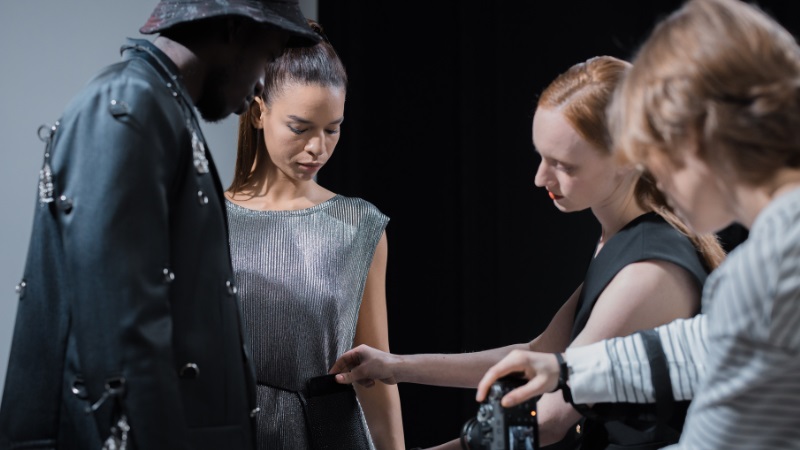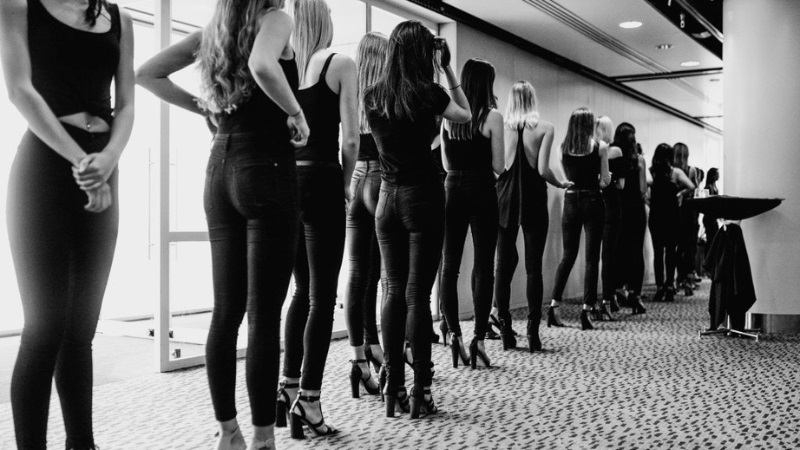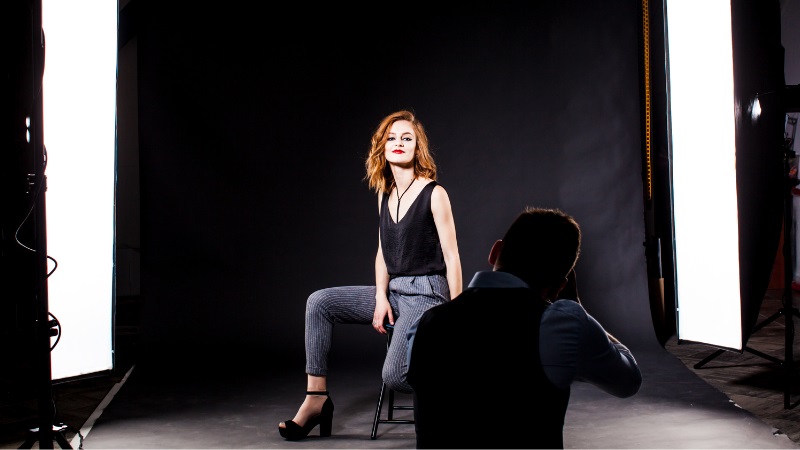
Thinking About Becoming A Model? Here is What to Expect
Working as a professional model involves representing clients from the fashion, beauty, and advertising industries through different means such as photo shoots or promotional events. Being an attractive candidate with certain physical attributes may set your foot in the door for pursuing this career path; attributes such as height, weight, body type, facial features, etc are prime candidates but having those little quirks that make heads turn can go a long way too!
Interpersonal skills play an important role here too considering models’ frequent interactions with stylists or photographers during shoots or shows while basic knowledge of fashion & design should come naturally if one intends on making it big here.
The competition is tough but for those who persist success comes not only with recognition but also comfortable earnings.
Is modelling an easy career?
As with any profession out there, modeling presents its unique set of challenges and requirements. It can be engaging and highly profitable; however, it takes more than just hard work or grit to succeed in this industry.
For starters, competition is intense – even for seasoned professionals – often making success elusive for aspiring models out there before they even get started in many cases.
Beyond this steep barrier stands the physical demands placed on models – requiring them always to keep up with strenuous fitness regimens. The job itself can also turn grueling too as long working hours become part-and-parcel when walking runways or posing for shoots day in and day out.
The unpredictability associated with trends changing quickly here adds another layer of complexity that makes the job all the more challenging on occasions too- demanding adaptability from all those involved continuously! Finally yet important comes excellent communication skills coupled with being open-minded enough when dealing effectively with different personalities every time!
In summary; Modeling is by no means an easy way up the ladder but instead takes talent; determination/mindset along grittier traits necessary for making headway in an ever-crowded sector where resilience counts just as much as experience does.
How long is a modeling career?
The duration of a modeling career is contingent on multiple variables such as age, background, market demand, and personal objectives.
Fashion models are at the pinnacle of their profession between late teens and early twenties with an average span of five to ten years. However, a handful of modeling professionals remain victorious beyond thirty years old.
Commercial models engaged in advertising and promotion enjoy extended careers as several demographic groups are targeted with varying body types.
Ultimately, the unpredictability of changes in market trends, maintaining good physiques, and staying connected with industry insiders determine the lifeline of any modeling career.
Is modelling good for career?
Whilst modeling certainly has its appeal as a career choice for some persons; however not everyone achieves complete satisfaction from it. This vocation demands people who possess specific physical features that are refined by unique skills and talent whilst also having good looks.
This line of work can furnish various challenges such as maintaining one’s visual image always being perfect – which is critical since it is their livelihood source – even if the working hours are unusual or extended.
Furthermore, there have been situations where models may have been subject to exploitation; hence this aspect should be taken into account before making future decisions regarding careers.
To become successful in this area of industry; having thorough knowledge about industry requirements through research will prove beneficial in understanding what potential employers are looking for in model candidates. Aligning oneself with reputable agencies whilst building strong relations with established professionals within this sector could benefit you considerably while developing an impressive portfolio will increase your chances further. Moreover, diverse expertise could aid in transitioning into other careers if necessary whenever times become difficult.
In conclusion, modeling professionals should possess strong mindset traits such as perseverance since competition demand models their all at every stage, but it’s possible to be extremely successful and lead an exciting life pursuing this career choice.
What is the first thing to do in modeling?
A career in modeling can be a dream come true but selecting the perfect opportunity may seem overwhelming at first glance because so many exist within this industry alone. The first thing required when pursuing this profession is determining which niche attracts you the most; whether it be magazines or runways. Commercial jobs like TV adverts or print publications? Fitness or plus-size domains?
It’s vital to match these choices according to your physical attributes as well as your abilities and passions so that choosing a path for yourself becomes easier thereafter. After making these decisions, building an exceptional portfolio consisting of high-quality headshots showcasing your best qualities becomes important.
Working with reputable agencies greatly increases chances of success: they provide valuable industry knowledge while ensuring visibility for their models in the right circles thereby securing opportunities for them too. Pursuing one’s goals through hard work combined with persistence leads up-to rewarding experiences within this competitive industry requiring passion at every stage from start to end!
What do models do when they get old?
As models’ careers age, they may take different paths as per individual goals and circumstances. Some choose to remain models for a long time beyond and into their middle ages while others explore different areas within fashion or entirely separate industries.
When it comes to older models, what is desirable is a more refined look that appeals to both editorial and commercial needs.
To be successful in high-pressure modeling situations such as photo shoots and fashion shows takes experience and supreme confidence in oneself and also a learned skillset that gives any production the edge it requires for success! Some older model professionals even transition into behind-the-scenes roles such as stylists or casting directors, using their years of wisdom gained from other ventures in the industry.
Their vast expertise enables these professionals not only can act as mentors but also to start producing projects themselves like becoming agents or establishing modeling agencies. Ultimately each model defines his/her path based on personal goals, opportunities available plus interests; retirement from modeling altogether isn’t uncommon at all! However many continue making an impact through diverse roles leveraging their acquired experience.
What are the disadvantages of modelling?
It’s vital to consider both sides of modeling before jumping into this career path. One potential drawback is the immense pressure that models face – competition in the fashion industry is fierce which necessitates maintaining a certain body shape and look at all times.
This constant scrutiny can harm mental health leading to eating disorders, anxiety, depression, or worse. Another challenge faced by models is unpredictability in income – since regular work appointments are few and far between, financial instability becomes a concern for many individuals pursuing this occupation.
On top of all this stress comes physical exhaustion from long hours spent standing or posing while waiting during shoots causing disruption in sleep patterns due to frequent travel schedules spanning across different time zones.
Unlike other professions where experience lends itself well with age; modeling leans towards favoring youthfulness with older professionals facing difficulties finding jobs available within their skillset let alone having trouble trying transitioning into new roles within their field.
Lastly, models can face exploitation, harassment, or other forms of abuse such as forced labor under unfavorable and hazardous conditions. Unfortunately, models are not immune to mistreatment in the fashion industry.
From photographers to agents there are many professionals who may take advantage of their vulnerable position. Before diving into a modeling career individuals should take stock of these risks and put their physical and mental well-being first.
Is modeling a skill or talent?
In the realm of modeling lies a combination of both skillsets and talent.
Skills refer to one’s ability to perform tasks competently; these abilities can be learned by way of practice and training over time. Such is the case with modeling – it requires proficiency that entails having poised poses while walking along a runway or maintaining engaging facial expressions utilized before cameras or an audience for better performance outcomes.
Talent refers more directly to innate traits possessed by individuals which make for their unique suitability within specific job areas; when it comes down to being model-worthy these talents might include photogenicity as well as charisma coupled with a fashionably strong sense of personal style – traits that offer distinct advantages within this industry.
However regardless if someone has natural-born modeling abilities they still need proper education through ongoing model training programs plus the practical experience in order to succeed within this field’s competitive environment; just like those without natural-born models having access to similar opportunities via dedication combined alongside applying themselves properly.
How do fashion models get noticed?
The modeling world is one where a blend of natural talent and acquired skills are crucial elements for success.
Skills encompass the ability to execute tasks effectively, which takes time via training and practice in order to attain proficiency in modeling. To thrive in this field requires poised poses on runways alongside captivating expressions before cameras or an audience for the best results.
Conversely, talent refers directly to innate qualities possessed by individuals that make them suitable for particular jobs; being model-worthy entails traits such as photogenicity plus charisma coupled with a keen understanding of personal style – characteristics that give considerable advantages within this industry.
Nevertheless, even if one has natural-born qualities suited towards modeling, it still necessitates appropriate learning through continuous training programs together with the hands-on experience necessary for triumph within this competitive environment – just like those without natural-born skills having comparable possibilities via applying themselves diligently.
How much does modelling cost?
Becoming a successful model means showcasing your unique beauty through professional photography and portfolios at an early stage in your career. The downside?
This usually entails dishing out substantial amounts of money depending upon factors such as photographer quality and specific shoot requirements essential for standing out amongst others in your industry.
If that’s not enough when starting out – there’s also traveling between gigs involved which comprises covering multiple expenses like lodging arrangements as well as transport costs no matter if one is attending a photo shoot or some other type of fashion event.
Additionally, some events require participants to cover additional expenditures like hair/makeup fees or buying special clothing items/accessories that are required on set.
It is important for those embarking down this career path with aspirations for success – to take into consideration all of these specific financial demands since clients/agents rarely offer reimbursements even though overall costs can add up significantly over time.
Therefore prior planning with realistic expectations alongside modeling salary prospects must come into play when starting out.
What do model scouts look out for?
Becoming a successful model is no easy feat but it all starts with showcasing your unique beauty in professional photos and portfolios. However, this initial step often requires investing large sums of money -especially if one wants to stand out from the crowd.
Photographers’ quality and specific shoot requirements are determining factors that can spike up the cost significantly.
Also starting models must be ready to travel between gigs which comes with multiple expenses such as lodging arrangements as well as transportation fees – whether one is attending a photo shoot or any other fashion event.
Some events go further and request participants to cough up additional funds for things like hair/makeup fees or buying special clothing/accessories that are necessary on set.
It’s essential for aspiring models to keep all these financial demands in mind given that clients/agents rarely offer reimbursements – even though costs can add up significantly over time.
Therefore proper planning, realistic expectations, and modeling salary prospects must be considered when embarking on this career path.
What do Modelling agencies look for?
Becoming a successful model isn’t an easy task – it necessitates appropriately displaying your unique beauty through professional photographs and portfolios. However, this fundamental step is often linked with significant upfront costs – especially if you wish to stand out from the crowd! The quality of photographers you work with as well as specific shoot requirements majorly impact your expenses.
Aspiring models must prepare themselves for regular travel between gigs which includes lodging arrangements and transportation fees -whether attending photo shoots or fashion events.The expenses that come with all this traveling adds up quickly.
Some events ask participants to cover additional payments for things like hair/makeup or purchasing specific clothing/accessories required on set.
Since clients/agents rarely offer reimbursements- even though the expenses incurred accumulate significantly over time – aspiring models should keep these financial demands in mind at all times.
Proper planning, realistic expectations, and modeling salary prospects are significant considerations when deciding if becoming a model is the right career path.
What should you not wear to a model casting?
Dressing appropriately plays an important role in making a positive first impression during modeling auditions. Here are some attire no-nos:
- Revealing clothing: If the outfit shows off too much skin or comes off as provocative, it may divert attention from essential aspects of modeling like skill and ability.
- Ill-fitting clothing: Loose-fitting outfits make one look unprofessional, unkempt, and not probably representing their best image during an audition.
- Heavy Make-up & Accessories: It’s better for casting directors to see model candidates as blank canvases they can work on; therefore overdoing on cosmetics or accessories is counterproductive.
- Busy Patterns/Logos: Clothing items featuring loud designs/brands may detract audiences’ attention from appreciating real assets models might possess instead of enhancing them.
- Sports Clothing: If not explicitly asked to do so, avoid wearing athletic attire that might limit the ability to showcase modeling potential.
In conclusion, dressing simply and professionally helps models bring out their true beauty and potential.
What are size 0 models?
Typically used during product development, a “size 0 model” tends to wear clothes marked as size zero – which represents the smallest available sizing option among numerous fashion brands today.
Although these so-called “trial size” mannequins serve an essential purpose by highlighting initial garment design elements effectively their usage has been met with increasing criticism over time due largely to concerns around promoting unrealistic body image expectations amongst the womenfolk. In response, however, we’re now seeing a push towards greater diversity within fashion modeling.
As such more and more models of varying heights and body types are featured in ad campaigns worldwide – a sign that the industry is slowly but surely moving in the right direction.
What should I wear to a model casting?
During product development cycles designers may rely on what’s known as a “size 0 model.” These models wear clothing labeled as size zero – the tiniest option offered by many prominent fashion brands.
Although these so-called “trial size” mannequins play an important role in showcasing initial garment designs effectively they’ve come under scrutiny for encouraging unrealistic beauty standards among female consumers. However, there has been an increase in efforts aimed at boosting diversity within the fashion industry lately.
More and more ad campaigns across numerous regions feature models with different body shapes and heights – demonstrating that progress is being made toward long-needed change.
What are 4 types of models?
Modeling is one career path where diversity is celebrated! Let’s take a look at four types of modeling to give you an idea of what’s out there:
First up are runway models – glamorous folks who strut their stuff down catwalks wearing the latest designer styles at fashion shows and events. Generally taller than most people (around 5’9″ – 6’0″) with slender builds runway models require specific measurements to ensure clothes will fit perfectly.
Next up are editorial models – these fashion darlings grace the pages of magazines or catalogs showcasing new trends (fashion/beauty). Having unique looks is key for editorial modeling!
Commercial modeling taps into advertising with various products/services like beauty products or household goods and this type of model can be seen on everything from billboards to online ads.
Lastly, fit models are hired by designers/manufacturers in order to create prototypes and test out these designs before they go into full-blown production. This requires precision measurements so that clothes can be made uniform across different body types.
What are face models called?
In the modeling industry face models are an essential part of advertising campaigns for skincare products, cosmetics, and hair care items known as “commercial” or “print” models respectively. Face modeling requirements go beyond just being gorgeous – they need to possess well-defined facial features that include unblemished skin with symmetrical contours creating an irresistible persona to their audience.
Moreover, it’s crucial for them to be able to portray a range of emotions through facial expressions since successful modeling projects require basic acting skills which allow Models to embody different characters or sentiments with ease. The role of face models spans different forms of media like billboards, print ads, online promotions, and TV commercials – showcasing their talent across various audiences worldwide.
Depending on what path they want to take in the industry; aspiring models can either opt for established agency representation or individual freelancing methods as per their aspirations and long-term goals.
What do you wear to a model walk in?
Participating in a model walk requires careful attention to fashion show organizers’ set requirements regarding attire options. Typically, once accepted into an event, detailed instructions will be given outlining everything from clothing choices to hairstyles/passing micro-details about accessories as well! Nevertheless, if no specific guidelines are indicated then make sure that you opt-in for simple but elegant clothing items – ones that highlight your best features while still supplying freedom of movement essential during catwalk displays.
Clothes that are too baggy or loose might prove counter-productive impeding proper posture evaluation or gait technique by judges looking over participants. Try on: a straightforward top/tank-top paired with skinny jeans/leggings, and finish with a comfortable pair of high heels which are safe for walking.
Avoid anything too flashy or distracting, and let your performance stand out – if the focus is on your outfit then something isn’t right! Remember what counts: feeling confident and comfortable when you step onto the runway and showcase your best self.
How are models chosen?
Choosing models involves much more than simply finding someone good-looking enough for the role at hand. Rather various factors must be examined including physical appearance where industry standards related to height, weight, body measurements, and facial features apply across different types of modeling jobs.
Work history including job experiences like past associations with prestigious brands along with runway events and photo shoots completed can also make or break a candidate’s chances of being chosen for the job at hand based on demonstrated competence in prior contexts. Equally significant are personality traits – qualities like professionalism combined with ease of work and ability to convey the brand image are all crucial attributes that brands look for in models.
Finally, social media has become a key consideration today with large followings on platforms like Instagram making an impact in terms of boosting brand awareness.
In general, models are picked based on the blend of features that suit a specific brand or task the most.
What do model agencies look for in a female?
The fashion industry has specific standards when it comes to female models’ physical attributes & personal qualities due to which modeling agencies scrutinize aspiring candidates under certain criteria such as:
- Height: Generally most runway & editorial positions call for women who stand above 173 cm tall. Body Proportions: Toned physique with well-defined skeletal structure along with body symmetrical proportions is what usually gets candidates shortlisted during initial casting calls
- Facial Features: Distinctive facial expressions like clear skin complexion pronounced facial structures, high cheekbones, full lips, or strong chin play an influential role when it comes down to choosing a model from many applicants. Age: Typically women ranging from late teens to mid-twenties tend to get hired more often by modeling agencies however it’s not uncommon for older individuals to land jobs depending on the job requirements.
- Personality: A good personality can make or break a model’s career. Positive attitude, professionalism & excellent communication skills are considered significant qualities in the industry as models work closely with photographers, designers, and other industry professionals.
Therefore it is key for an aspiring female model to embody these desirable traits when entering this field. For female models, having some background experience in modeling could prove advantageous although it’s not always necessary.
The such experience reflects competence and familiarity with the trade; nonetheless, there is no guaranteed method of becoming successful as a model since each individual case is distinct.
Model agencies look out for distinguishing features within potential applicants which increase their chances of standing out amidst fierce competition within the industry.
Is it hard to become a model?
Becoming a model is an uphill battle that requires resilience amidst challenging competition around every corner. While courses or formal education may help prepare budding models for these challenges there are still numerous factors that contribute to making it difficult for individuals wanting success in modeling:
Firstly height and body type remain significant hurdles for most people wanting to pursue fame in modeling circles; preferably over 5 feet 7 inches tall while maintaining toned physiques give hopefuls an edge. Age plays another role too once someone decides to pursue modeling since younger models tend to be a preferred demographic.
Thirdly the limited number of opportunities combined with the ever-increasing pool of talent seeking these jobs translate into fewer chances for new entrants.
Finally, industry standards determine what looks, styles and poses make a model successful. Aspiring models must adapt themselves to these expectations to ever stand a chance in this competitive field.
Let’s not beat around the bush here: becoming a model is not for the faint-hearted. Nevertheless, if you’ve got gritted teeth and unwavering drive on your side (and maybe just a sprinkle of good fortune!) there’s no reason why achieving success isn’t feasible.
The key takeaway is time and dedication are what will pay off ultimately in this field but with resilience when faced with setbacks along the way!




